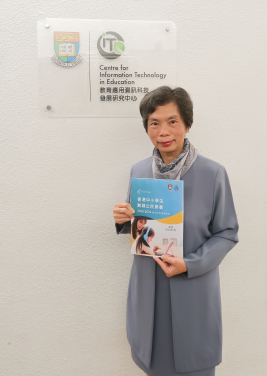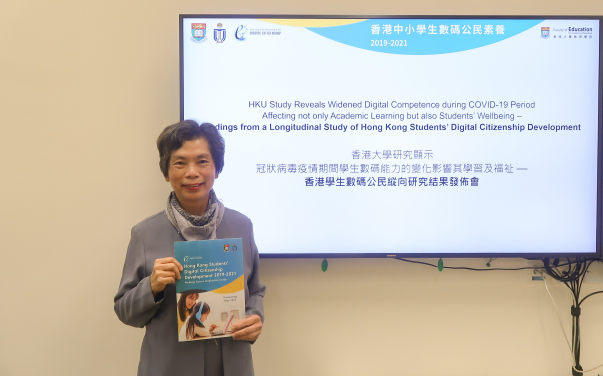Media
HKU Study Reveals Widened Digital Competence Divide During COVID-19 Period Affecting Not Only Academic Learning but also Students’ Wellbeing – Findings from a Longitudinal Study of Hong Kong Students’ Digital Citizenship Development
03 May 2022

Professor Nancy Law, Deputy Director, Centre for Information Technology in Education, Faculty of Education, HKU

Professor Nancy Law, Deputy Director, Centre for Information Technology in Education, Faculty of Education, HKU
- 1 / 2
- 2 / 2
The findings from the longitudinal component of the Learning and Assessing in Digital Citizenship (“eCitizen”) Project were released today (May 3). The “eCitizen” Project is a longitudinal study that investigates how key aspects of digital citizenship develop from childhood to early adulthood and how contexts, such as school and home factors contribute to this development. This project is funded by the Research Grants Council under the Theme-based Research Scheme, and it is conducted by an interdisciplinary research team and led by Professor Nancy Law, Deputy Director, Centre for Information Technology in Education, Faculty of Education, The University of Hong Kong (HKU). The research team comprises prominent researchers from HKU and the Hong Kong University of Science and Technology and international experts, from the fields of Education, Learning Sciences and Learning Technology, Computer Science and Engineering, Social Science, Arts, Journalism, Paediatrics and Adolescent Medicine.
Analyses of the changes that took place between 2019 and 2021 show that though the general digital competence of students have improved, students’ digital competence gap within and across schools have increased significantly. The study also revealed significant increases in the percentage of students reporting serious mental health and internet addiction conditions in all three age cohorts studied: primary, lower secondary and upper secondary.
Over 2,000 students from 18 primary schools and 14 secondary schools took part in the study. The first wave of data collection from primary 3 (cohort 1), secondary 1 (cohort 2) and secondary 3 (cohort 3) students was conducted in the 2018/2019 school year. The second wave of data collection was conducted on the same set of students from April to July 2021, more than a year after the onset of the COVID-19 pandemic.
Major findings
Students’ digital competence in 2021, and the growth and development observed since 2019:
- A significant increase in students’ digital literacy (DL) is observed for all cohorts. Moreover, it is observed that the DL performance of primary 5 students in 2021 was similar to secondary 1 students in 2019, and secondary 3 students in 2021 significantly outperformed the secondary 3 students in 2019.
- While most students improved in their DL, there are some students in each of the cohorts who had in fact regressed in their DL.
- On the other hand, the students’ mean collaborative problem-solving ability, another aspect of digital competence, did not improve over the two years.
Differences in digital performance exist within and between schools:
- The within school and between school DL performance gap has increased significantly over the two years, and the widening gap was even more serious at the secondary school level.
- In all three age cohorts, students in some high performing schools were able to improve their DL greatly while keeping a relatively small DL divide within the school; the reverse is observed in some other schools.
- In 2021, the primary 5 students’ DL performance in the best performing primary school was better than the overall DL performance of the entire cohort 3 (secondary 5) students.
- In 2021, the secondary 5 students’ DL performance in the lowest performing secondary school was poorer than the overall DL performance of the entire cohort 1 (primary 5) students.
Digital literacy divides and students’ socioeconomic status (SES):
- The study adopted two family SES indicators: Academic Social Capital (based on the parents’ education level and the number of books at home) and Home Resources (based on whether the student has their own room, own study desk, and/or a quiet place to study).
- Family SES is positively related to students’ DL achievement, but only significant for the two younger cohorts.
- Academic Social Capital is more important than the Home Resources in influencing students’ DL score and the extent of the growth between 2019 and 2021.
- The effect of SES on DL achievement was observed only at the school level, meaning that the overall DL performance of students studying in schools with higher mean SES were higher, but an individual student’s family SES did not affect his/her individual DL compared to students in the same school.
Hong Kong students’ wellness changes between 2019 and 2021:
- Students’ mental health deteriorated significantly during the two waves of data collection, with the percentage of students reporting severe mental health problems increasing from 6.2% to 13.5% for cohort 2 students, and from 9.5% to 17.9% for cohort 3 students. 9.2% of surveyed primary 5 students reported suffering from serious mental health problems in 2021.
- The percentage of students reporting symptoms indicative of Internet addiction also increased from 8% in 2019 to 20% for secondary students, and 15% of primary 5 students reported symptoms of Internet addiction in 2021.
- The extent to which students reported game addiction did not change much during the two years, with a higher level reported by cohorts 1 & 2 students at 7% to 8% and by cohort 3 students at 4% only. There is a higher percentage of boys reporting game addiction than girls for all three cohorts in both 2019 and 2021.
- About 25% of students experienced cyberbullying either as a bully and/or as a victim during the three months before the survey in 2021. There is a high correlation between being a bully and being a victim (0.53), and 40-50% of the students who had experienced cyberbullying reported having been both a victim and a cyberbully. There is a high probability for those who reported having experienced cyberbullying in 2019 to also report having experienced cyberbullying in 2021 (40% in cohort 1, 62% in cohort 2, 57% in cohort 3, and 55% averaged across all three cohorts).
Digital technology use, digital literacy, and students’ wellbeing:
- Due to sustained periods of schooling suspension, students have been spending much more time online for learning and for leisure activities. This also increased the probability for students to encounter negative digital experiences (e.g. online security problems and being cyberbullied), or to engage in problematic digital behaviour (e.g. engaging in risky online communications or to cyberbully others). Such experiences could be a source of stress that leads to threats to their wellbeing.
- Our analysis shows that DL is a protective factor that suppresses the potential negative impact associated with time spent on using digital devices on mental health.
- In all three cohorts in both 2019 and 2021, we find that the total effect of time spent on digital devices on mental health to be not statistically significant. This indicates that the significant increases in mental health problems from 2019 to 2021 were due to other factors that were not directly related to the amount of time students spent on digital devices.
What activities contribute to students’ DL development?
- Our study found that only exploratory learning activities (e.g. seeking for information online, discussing schoolwork with peers or teachers) at home has a positive and significant correlation with students’ DL performance, and this relationship was even stronger in 2021.
- Learning activities that are tightly directed by teachers, whether conducted at school or at home are negative predictors of students’ DL achievement, and this negative relationship was even stronger in 2021.
- Engaging in digital leisure activities at home was a positive predictor of DL performance in 2021.
Were there sustained negative impact on DL development for students without large screen devices in 2019?
- Students who did not have access to large screen devices (LSDs) at home in 2019 suffered in their DL achievement. The adverse effect is more prominent for the older students involved.
- For the primary students who did not have LSDs in 2019 but had LSDs in 2021, they were able to catch up with the rest of the cohort.
- For cohorts 2 & 3 students without LSDs in 2019, they were able to achieve similar growth as the rest of their cohorts, but the difference in DL achievements remained.
Implications of the findings
“From the findings, we can see that the overall digital literacy of students across the primary and secondary grade levels have greatly improved during the period 2019 to 2021 to surpass the achievement reached by students in a comparable age group in 2019. This is possibly due to the pervasive use of digital technology for learning and for leisure during the pandemic. However, the greatly increased digital competence divide is extremely concerning. Moreover, we see that the DL divide was much increased in 2021 even though a large majority of students already have LSDs at home and students’ growth in DL did not suffer if they had LSDs in 2021. This shows that simply improving digital devices access cannot solve the widening problem of the digital literacy gap,” said Professor Nancy Law, who led the study.
“There is an awareness that on-line and off-line blended learning is here to stay even after the pandemic, but how should this be done to foster digital literacy and build online resilience is the challenge,” said Mr So Ping Fai, Principal of Tin Shui Wai Methodist Primary School and a member of the eCitizen Advisory Committee, who further pointed out that most teachers lack understanding of DL.
“The challenge we are facing is no longer access to devices or the lack of technical skills. We need to help children develop soft skills such as the ability to differentiate facts from opinions, to identify fake news, and to be able to focus and self-regulate their own activities online,” Mr Charles Chan, Executive Director of the Boys and Girls Clubs Association of Hong Kong commented.
Mr Eugene Fong, a board member of the Child Development Initiative Alliance, argued that there is an urgent need to also raise the awareness and understanding about DL among parents as well as the general public, as they are also digital citizens.
Professor Law expected the gigantic DL divide to negatively impact on students’ academic learning and further exacerbate the overall learning divide among students. Mr Stanley Kam, Vice Chairman of The Hong Kong Association for Computer Education, expressed the hope that further research can shed light on the extent to which students’ learning has been affected due to the pandemic, and in what ways students’ DL and other factors made a difference to students’ learning outcomes.
“The greatly deteriorated mental health situation and other digital wellness conditions are deeply worrying. It is good to know that DL serves as a protective factor for students’ wellbeing. Research has shown that online resilience has to be facilitated through digital technology use and not simply through restrictions.” Professor Law said in conclusion, “It is imperative that measures be taken to support schools and teachers in developing appropriate learning environments and activities that will foster digital competence and resilience. Concerted efforts involving community sectors in addition to the educators are necessary to address the wellness challenges and the learning divides uncovered through this research.”
For more details of the “e-Citizen” Project, please visit: https://ecitizen.hk/. To review the e-version of the press release, and download photos and presentation file, please visit http://web.edu.hku.hk/press.
For the powerpoint slides presented at the media conference, please click here.
For media enquiries, please contact Ms Emily Cheung, Senior Manager (Development and Communications), Faculty of Education, HKU (Tel: 3917 4270 / Email: emchy@hku.hk), or Dr Sisi Tao, Project Manager, Digital Citizenship Project, Faculty of Education, HKU (Tel: 3917 7636 / 5693 5940 / Email: sisitao@hku.hk).
